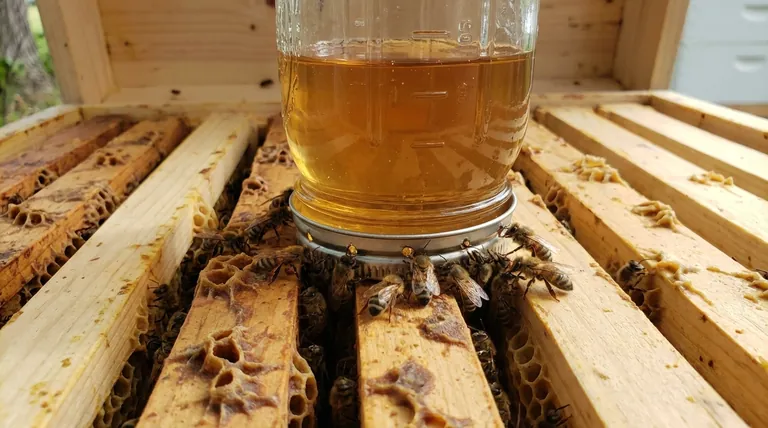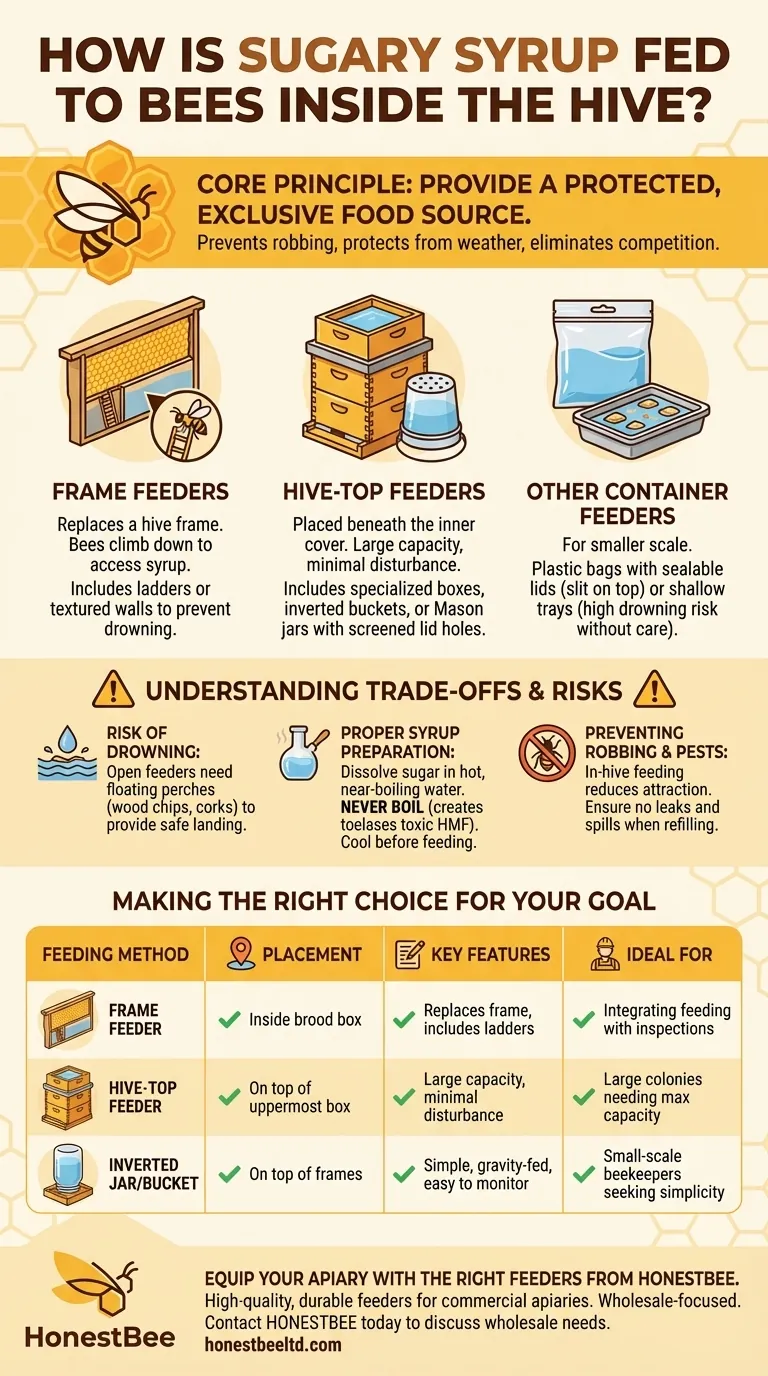In-hive feeding is accomplished using feeders that either replace a frame within the hive body or sit on top of the hive stack. The most common types are frame feeders, which hang inside the hive like a standard frame, and hive-top feeders, which can be a specialized box or a simple inverted container with small holes.
The core principle of in-hive feeding is to provide a protected, exclusive food source for your colony. This method prevents robbing by other bees, protects the syrup from weather, and eliminates competition from other insects, ensuring your bees get the full benefit of the feed.

The Primary In-Hive Feeding Methods
Choosing how to feed your bees inside the hive depends on the size of your colony, the season, and your management style. Each method offers a different balance of capacity, convenience, and risk.
Frame Feeders
A frame feeder is a plastic or wooden container shaped like a standard hive frame. It's placed inside the brood box or super, taking the place of one or two frames.
Bees climb down into the feeder to access the syrup. Many modern designs include ladders or textured interior walls to help prevent bees from drowning.
Hive-Top Feeders
These feeders are placed on top of the uppermost hive box, just beneath the inner cover and lid. This allows for very large volumes of syrup to be fed with minimal disturbance to the colony.
Common types include specially designed boxes that cover the entire top of the hive or simpler inverted containers. An inverted bucket or Mason jar with small, screened holes in the lid is a very common method for beekeepers of all scales. Gravity and vacuum pressure prevent the syrup from pouring out, releasing it only as bees consume it.
Other Container Feeders
For smaller-scale feeding, plastic bags with sealable lids can be used. A small slit is cut in the top of the bag after it's placed over the top bars of the frames.
Similarly, a shallow tray can be placed on top of the frames. However, this method presents a high risk of drowning if not managed carefully.
Understanding the Trade-offs and Risks
While in-hive feeding is the preferred method, it's crucial to understand the potential pitfalls to ensure the safety and health of your colony.
The Risk of Drowning
Open-style feeders, such as frame feeders or shallow trays, pose a significant drowning risk to bees.
If using one of these, it is essential to provide a floating perch, such as wood chips, corks, or a purpose-built plastic float, to give bees a safe place to land.
Proper Syrup Preparation is Critical
The sugar syrup itself must be prepared correctly to be safe for bees. Use hot, near-boiling water to dissolve the sugar completely.
Never boil the sugar-water mixture. Boiling can create a compound called Hydroxymethylfurfural (HMF), which is toxic to bees. The finished syrup should be a clear, light straw color and must be cooled to room temperature before being given to the colony.
Preventing Robbing and Pests
Feeding inside the hive dramatically reduces the chance of attracting bees from other colonies or pests like wasps.
Ensure your feeder does not leak and avoid spilling any syrup on or around the hive when refilling it, as this can trigger a robbing frenzy.
Making the Right Choice for Your Goal
Select a feeder that aligns with your colony's needs and your ability to manage it safely.
- If your primary focus is maximum capacity for a large colony: A hive-top feeder is the most efficient choice, holding gallons of syrup and requiring less frequent refilling.
- If your primary focus is simplicity for a small hive: An inverted Mason jar feeder is easy to set up, clean, and monitor syrup levels at a glance.
- If your primary focus is integrating feeding with hive inspections: A frame feeder is a convenient option, as it can be refilled during your regular colony checks.
Ultimately, the best method is one that delivers food safely and effectively, supporting your colony's health and growth.
Summary Table:
| Feeding Method | Placement | Key Features | Ideal For |
|---|---|---|---|
| Frame Feeder | Inside the brood box | Replaces a frame, includes ladders to prevent drowning | Integrating feeding with hive inspections |
| Hive-Top Feeder | On top of the uppermost box | Large capacity, minimal disturbance | Large colonies needing maximum capacity |
| Inverted Jar/Bucket | On top of the frames | Simple, gravity-fed, easy to monitor | Small-scale beekeepers seeking simplicity |
Equip Your Apiary with the Right Feeders from HONESTBEE
Choosing the correct feeding system is crucial for the health and productivity of your bees. At HONESTBEE, we supply commercial apiaries and beekeeping equipment distributors with high-quality, durable feeders designed for safety and efficiency.
Our wholesale-focused operations ensure you get the reliable equipment you need to support your colony's growth. Let us help you make the best choice for your operation.
Contact HONESTBEE today to discuss your wholesale needs and keep your colonies thriving!
Visual Guide

Related Products
- Professional 3-Bar Frame Grip with Integrated Hive Tool
- HONESTBEE Advanced Ergonomic Stainless Steel Hive Tool for Beekeeping
- Professional Dual-End Stainless Steel Hive Tool for Beekeeping
- Beehive Handle and Frame Rest Cutting Machine: Your Specialized Hive Machine
- Manual Spur Wheel Wire Embedder for Foundation
People Also Ask
- Why is proper beekeeping equipment important? Essential for Safety and Hive Health
- How do you use Frame Grips during hive inspections? Achieve Calmer, More Efficient Hive Inspections
- What are the benefits of using Frame Grips in beekeeping? Boost Efficiency & Protect Your Hive
- What does every bee keeper need? Your Essential Guide to Starting Strong
- What parts of bee equipment should be painted? A Guide to Protecting Your Hive and Your Bees



















